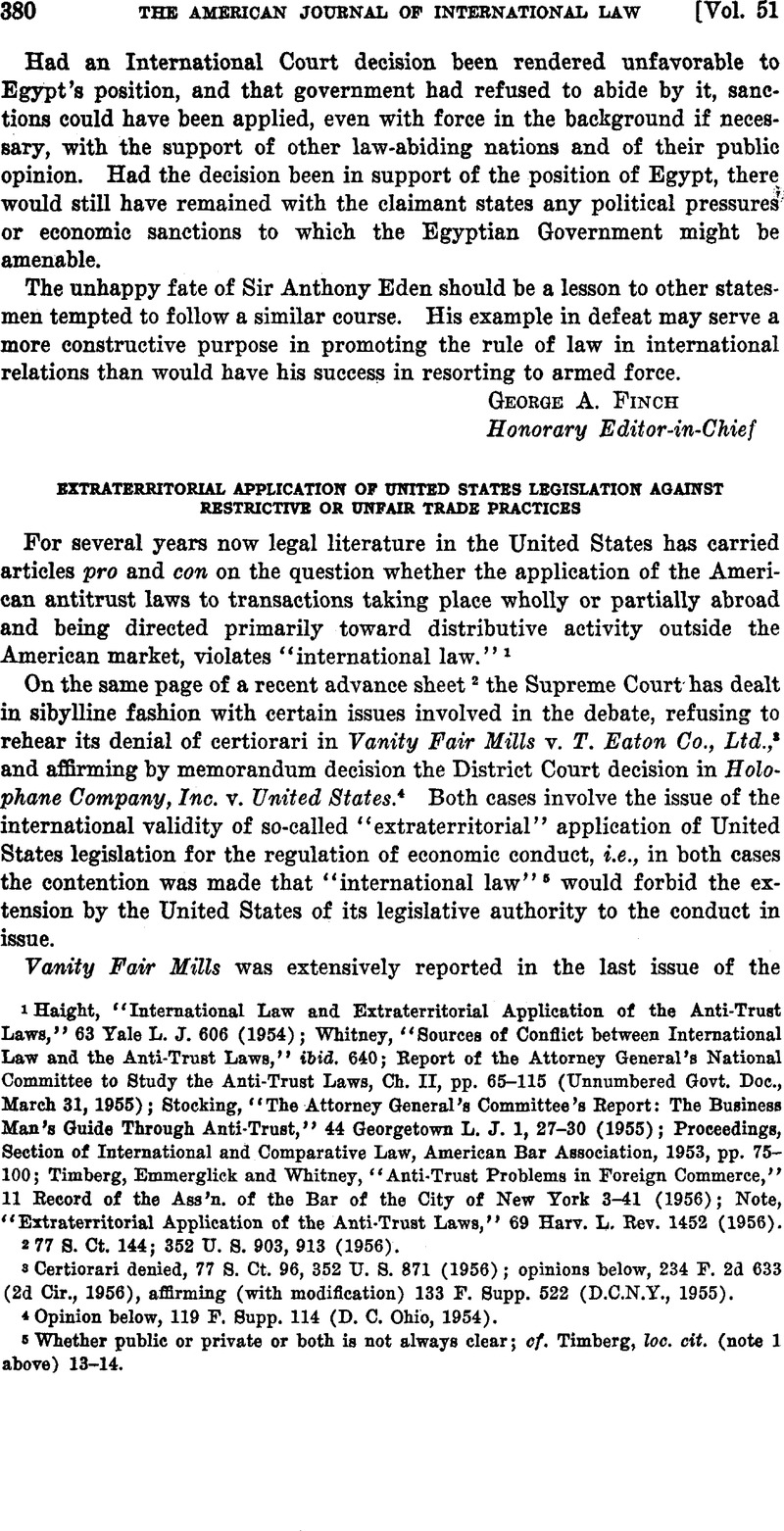No CrossRef data available.
Published online by Cambridge University Press: 28 March 2017

1 Haight, , “International Law and Extraterritorial Application of the Anti-Trust Laws,” 63 Yale L. J. 606 (1954)CrossRefGoogle Scholar; Whitney, “Sources of Conflict between International Law and the Anti-Trust Laws,” ibid. 640; Report of the Attorney General’s National Committee to Study the Anti-Trust Laws, Ch. II, pp. 65–115 (Unnumbered Govt. Doc., March 31, 1955); Stocking, , “The Attorney General’s Committee’s Report: The Business Man’s Guide Through Anti-Trust,” 44 Georgetown L. J. 1, 27–30 (1955)Google Scholar; Proceedings, Section of International and Comparative Law, American Bar Association, 1953, pp. 75–100; Timberg, , Emmerglick, and Whitney, , “Anti-Trust Problems in Foreign Commerce,” 11 Record of the Ass’n. of the Bar of the City of New York 3–41 (1956)Google Scholar; Note, “Extraterritorial Application of the Anti-Trust Laws,” 69 Harv. L. Rev. 1452 (1956)CrossRefGoogle Scholar.
2 77 S. Ct. 144; 352 U. S. 903, 913 (1956).
3 Certiorari denied, 77 S. Ct. 96, 352 U. S. 871 (1956) ; opinions below, 234 F. 2d 633 (2d Cir., 1956), affirming (with modification) 133 F. Supp. 522 (D.C.N.Y., 1955).
4 Opinion below, 119 F. Supp. 114 (D. C. Ohio, 1954).
5 Whether public or private or both is not always clear; cf. Timberg, loc. cit. (note 1 above) 13–14.
6 51 A.J.I.L. 103 (1957).
7 344 U. S. 280 (1952); digested in 47 A.J.I.L. 318 (1953).
8 133 F. Supp. 522, 528–529, and Court’s notes.
9 234 F. 2d 633, 647.
10 Findings of Fact Nos. 10 and 11, 119 F. Supp. 114, 116.
11 New York Times, Nov. 14, 1956, Financial Section.
12 1954 Trade Cases ¶ 67,679 should be referred to for the terms of the decree. Par. XI is the portion of the decree, paraphrased in the text above, requiring affirmative competitive action by the defendant. The affirmance by even division is tantalizing.
13 Two members of the California Bar with experience and professional interest in the future of antitrust decrees directing conduct abroad expressed such expectations during their participation in the Second Summer Workshop in International Legal Studies at the University of California School of Law (Berkeley), 1956.
14 25 Law Week 3141 (1956).
15 Cf. Haight and Whitney, loc. cit. (note 1 above). It is assumed throughout this editorial that the type of “jurisdiction” under discussion is that relating to capacity to attach legal consequences to conduct, not power to apply state power in direct enforcement of commands. Obviously the territorial principle is exclusive in the latter situation, unless the territorial state has waived in some way its otherwise sovereign power to execute laws within its borders.
16 As in the well-known incidents involving (i) the efforts to subpoena foreign-held records of the Canadian pulp and paper consortium and those of the Anglo-Iranian Oil Company; (ii) the impasse with respect to the nylon patents in Great Britain. In Be Grand Jury Subpoena Duces Tecum, 72 F. Supp. 1013 (S.D.N.Y., 1947) ; In Ee Investigation of World Arrangements, 107 F. Supp. 628 (D.C.D.C., 1952); U. S. v. Imperial Chemical Industries, 105 F. Supp. 215 (D.C.S.D.N.Y., 1952); British Nylon Spinners v. Imperial Chemical Industries, [1953] 1 Ch. 19.
17 See Timberg, , “International Combines and National Sovereigns,” 95 U. Pa. L. Rev. 575 (1947)CrossRefGoogle Scholar; and cf. Stocking, loc. cit. (note 1 above); Schwartz, , “Committees, Politics, Scholarship and Law Reform: Antitrust Studies in Perspective,” 104 U. Pa. L. Rev. 153 (1955)CrossRefGoogle Scholar.
18 Cf. Jessup, Transnational Law (1956), reviewed below, p. 444.